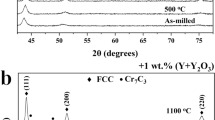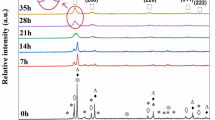Abstract
Four component Cr0.21Fe0.20Al0.41Cu0.18 medium entropy alloy (Quaternary, 4C-MEA) and six component Cr0.14Fe0.13Al0.26Cu0.11Si0.25Zn0.11 high entropy alloy (sexinary, 6C-HEA) were designed and developed in non-equiatomic ratio to attain improved mechanical properties. These 4C-MEA, and 6C-HEA were synthesized via mechanical alloying (MA), and consolidated by hot pressing (HPing) at 723 K. For comparison, the same atomic ratio of four and six components of coarse grain alloys (4C-CGA and 6C-CGA) were also manufactured by conventional blending method. Nanocrystallite size powders of 27 ± 5.20 nm and 38 ± 3.7 nm were achieved for 4C-MEA and 6C-HEA respectively after 20 h MA. The phase evolutions, structural properties, and powder surface morphologies were characterized using X-ray diffraction and several electron microscopes. The 4C-MEA has possessed more quantity of body centred cubic (BCC) and less amount of face centred cubic (FCC) phases due to the more solid dissolution of 4 components. However, 6C-HEA exhibited more quantity of FCC and a small amount of BCC phases due to the incorporation of more FCC components compared to 4C-MEA and less solid dissolution due to more atomic radius difference among the mixing elements (atomic radius of Cr = 166 pm, Fe = 156 pm, Al = 118 pm, Cu = 145 pm, Si = 111 pm and Zn = 142 pm). The HPed samples produced ultra-fine crystallite size of 177 nm and 499 nm for 4C-MEA and 6C-HEA respectively. Further, 4C-MEA and 6C-HEA exhibited the ultimate compressive strength (UCS) of 365 MPa and 456 MPa respectively due to dissolution and lattice distortion of mixing elements. Also, 6C-HEA possessed Vickers hardness strength of around 1.97 GPa which was 2 times higher than 4C-MEA. The theoretical background of various strengthening mechanisms, various physicochemical, thermodynamic parameters, and four core effects behind the improved properties in entropy alloys was discussed and reported. The dislocation strengthening and solid solution strengthening were the major factors in exhibiting more UCS in 4C-MEA and 6C-HEA than 4C-CGA and 6C-CGA.
Graphic Abstract












Similar content being viewed by others
Data Availability Statement
The experimental datasets obtained from this research work and then the analyzed results during the current study are available from the corresponding author on reasonable request.
Abbreviations
- MEA:
-
Medium entropy alloy
- HEA:
-
High entropy alloy
- MA:
-
Mechanical alloying
- HP:
-
Hot press
- CGA:
-
Coarse grain alloy
- XRD:
-
X-ray diffraction
- BCC:
-
Body centered cubic
- FCC:
-
Face centered cubic
- HCP:
-
Hexagonally close packed
- VHP:
-
Vacuum hot pressing
- SPS:
-
Spark plasma sintering
- UCS:
-
Ultimate compressive strength
- VHS:
-
Vickers hardness strength
- SS:
-
Solid solution
- FWHM:
-
Full-width-half-maximum
- HRTEM:
-
High-resolution transmission electron microscope
- FEGHRSEM:
-
Field emission gun scanning electron microscope
References:s
G.E. Totten, L. Xie, K. Funatani, Hand Book of Mechanical Alloy Design (Marcel Dekker Inc, New York, 2004)
S. Mohanty, N.P. Gurao, P. Padaikathan, K. Biswas, Ageing behaviour of equiatomic consolidated Al20Co20Cu20Ni20Zn20 high entropy alloy. Mater. Charact. 129, 127–134 (2017)
C.Y. Hsu, J.W. Yeh, S.K. Chen, T.T. Shun, Wear resistance and high-temperature compression strength of FCC CuCoNiCrAl0.5Fe alloy with boron addition. Metall. Mater. Trans. A 35(A), 1465–1469 (2004)
J.W. Yeh, S.K. Chen, Y.L. Chen, Novel alloy concept, challenges and opportunities of high-entropy alloys, in Frontiers in the Design of Materials, ed. by B. Raj (CRC Press, New York, 2007), pp. 31–47
B. Cantor, I.T.H. Chang, P. Knight, A.J.B. Vincent, Microstructural development in equiatomic multicomponent alloys. Mater. Sci. Eng. A 375–377, 213–218 (2004)
K.M. Youssef, A.J. Zaddach, C. Niu, D.L. Irving, C.C. Koch, A novel low-density, high-hardness, high-entropy alloy with close-packed single-phase nanocrystalline structures. Math. Res. Lett. 3, 95–99 (2014)
C.Y. Hsu, J.W. Yeh, S.K. Chen, T.T. Shun, Wear resistance and high-temperature compression strength of FCC CuCoNiCrAl0.5Fe alloy with boron addition. Matall. Mater. Trans. 35(A), 1465–9 (2004)
Y.Y. Chen, T. Duval, U.D. Hung, J.W. Yeh, H.C. Shih, Microstructure and electrochemical properties of high entropy alloys e a comparison with type-304 stainless steel. Corros. Sci. 47, 2257–2279 (2005)
J.M. Wu, S.J. Lin, J.W. Yeh, S.K. Chen, Y.S. Huang, H.C. Chen, Adhesive wear behaviour of AlxCoCrCuFeNi high-entropy alloys as a function of aluminum content. Wear 261, 513–519 (2006)
K.B. Zhang, Z.Y. Fu, J.Y. Zhang, W.M. Wang, H. Wang, Q.J. Zhang et al., Microstructure and mechanical properties of CoCrFeNiTiAlx high-entropy alloys. Mater. Sci. Eng. A 508, 2149 (2009)
X.F. Wang, Y. Zhang, Y. Qiao, G.L. Chen, Novel microstructure of multicomponent CoCrCuFeNiTix alloys. Intermetallics 15, 357–362 (2007)
B.S. Murty, J.W. Yeh, S. Ranganathan, High-Entropy Alloys (Butterworth-Heinemann, London, UK, 2014)
M. Vaidya, G.M. Muralikrishna, B.S. Murty, High-entropy alloys by mechanical alloying: a review. J. Mater. Res. 34(5), 664–686 (2019). https://doi.org/10.1557/jmr.2019.37
W.H. Liu, Z.P. Lu, J.Y. He, J.H. Luan, Z.J. Wang, B. Liu, Y. Liu, M.W. Chen, C.T. Liu, Ductile CoCrFeNiMox high entropy alloys strengthened by hard intermetallic phases. Acta Mater. 116, 332–342 (2016)
D.B. Miracle, Critical assessment 14: high entropy alloys and their development as structural materials. Mater. Sci. Technol. 31(10), 1142–1147 (2015)
D. Ma, M. Yao, K. Pradeep, C.C. Tasan, H. Springer, D. Raabe, Phase stability of non-equiatomic CoCrFeMnNi high entropy alloys. Acta Mater. 98, 288–296 (2015)
S. Praveen, J. Basu, S. Kashyap, R.S. Kottada, Exceptional resistance to grain growth in nanocrystalline CoCrFeNi high entropy alloy at high homologous temperatures. J. Alloys Compd. 662, 361 (2016)
C. Suryanarayana, Mechanical alloying and milling. Prog. Mater. Sci. 46, 1 (2001)
S. Varalakshmi, M. Kamaraj, B.S. Murty, Synthesis and characterization of nanocrystalline AlFeTiCrZnCu high entropy solid solution by mechanical alloying. J. Alloys Compd. 460, 253–257 (2008)
X. Liu, H. Cheng, Z. Li, H. Wang, F. Chang, W. Wang, Q. Tang, P. Dai, Microstructure and mechanical properties of FeCoCrNiMnTi0.1C0.1 high-entropy alloy produced by mechanical alloying and vacuum hot pressing sintering. Vacuum 165, 297–304 (2019)
A.I. Yurkova, V.V. Cherniavsky, V. Bolbut, M. Krüger, I. Bogomol, Structure formation and mechanical properties of the high-entropy AlCuNiFeCr alloy prepared by mechanical alloying and spark plasma sintering. J. Alloys Compd 786, 139–148 (2019)
C.-L. Chen, Effects of nano-dispersoids on synthesis and characterization of low Crcontaining CoNiFeMnCr high entropy alloy by mechanical alloying. Intermetallics 113, 106570 (2019)
Hu Cheng, X. Liu, Q. Tang, W. Wang, X. Yan, P. Dai, Microstructure and mechanical properties of FeCoCrNiMnAlx high-entropy alloys prepared by mechanical alloying and hot-pressed sintering. J. Alloys Compd. 775, 742–751 (2019)
S. Sivasankaran, K. Sivaprasad, R. Narayanasamy, V.K. Iyer, An investigation on flowability and compressibility of AA 6061100−x−x wt.% TiO2 micro and nanocomposite powder prepared by blending and mechanical alloying. Powder Technol. 201, 70–82 (2010)
K.R. Ramkumar, S. Sivasankaran, A.S. Alaboodi, Effect of alumina content on microstructures, mechanical, wear and machining behavior of Cu–10Zn nanocomposite prepared by mechanical alloying and hot-pressing. J. Alloys Compd. 709, 129–141 (2017)
C.L. Chen, Y. Zeng, Synthesis and characteristics of W-Ti alloy dispersed with Y2Ti2O7 oxides. Int. J. Refract. Metals Hard Mater. 56, 104–109 (2016)
C. Wang, W. Ji, Z. Fu, Mechanical alloying and spark plasma sintering of CoCrFeNiMnAl high-entropy alloy. Adv. Powder Technol. 25, 1334–1338 (2014)
J.Y. Huang, Y.D. Yu, Y.K. Wu, D.X. Li, H.Q. Ye, Microstructure and nanoscale composition analysis of the mechanical alloying of FexCu100−x (X = 16, 60). Acta Mater. 45, 113–124 (1997)
Y.L. Chen, Y.H. Hu, C.A. Hsieh, J.W. Yeh, S.K. Chen, Competition between elements during mechanical alloying in an octonary multi-principal-element alloy system. J. Alloys Compd. 481, 768–775 (2009)
X. Yang, Y. Zhang, Prediction of high-entropy stabilized solid solution in multi-component alloys. Mater. Chem. Phys. 132(2e3), 233–238 (2012)
K.R. Ramkumar, S. Sivasankaran, F.A. Al-Mufadi, S. Siddharth, R. Raghu, Investigations on microstructure, mechanical, and tribological behaviour of AA 7075−x wt.% TiC composites for aerospace applications. Arch. Civ. Mech. Eng. 19, 428–438 (2019)
X. Liu, H. Cheng, Z. Li, H. Wang, F. Chang, W. Wang, Q. Tang, P. Dai, Microstructure and mechanical properties of FeCoCrNiMnTi0.1C0.1 high entropy alloy produced by mechanical alloying and vacuum hot pressing sintering. Vacuum 165, 297–304 (2019)
A. Singh, K.N. Kumar, A. Dwivedi, A. Subramanian, A geometrical parameter for the formation of disordered solid solutions in multi-component alloys. Intermetallics 53, 112–119 (2014)
Y. Zhang, Y.J. Zhou, J.P. Lin, G.L. Chen, P.K. Liaw, Solid-solution phase formation rules for multi-component alloys. Adv. Eng. Mater. 10(6), 534–538 (2008)
S. Guo, C. Ng, J. Lu, C.T. Liu, Effect of valence electron concentration on stability of fcc or bcc phase in high entropy alloys. J. Appl. Phys. 109(10), 103505 (2011)
R. Sriharith, B.S. Murty, R.S. Kottada, Alloying, thermal stability and strengthening in spark plasma sintered AlxCoCrCuFeNi high entropy alloys. J. Alloys Compd. 583, 419–426 (2014)
W.F. Smith, J. Hashemi, Foundations of Materials Science and Engineering, 4th edn. (McGraw-Hill, New York, 2006)
M.A. Meyers, K.K. Chawla, Mechanical Behavior of Materials, 2nd edn. (Cambridge University Press, Cambridge, 2009)
S. Takaki, Mater. Sci. Forum. 638–642, 168–173 (2010)
H. Zhang, Y. Yang, L. Liu, C. Chen, T. Wang, R. Wei, T. Zhang, Y. Dong, F. Li, A novel FeCoNiCr0.2Si0.2 high entropy alloy with an excellent balance of mechanical and soft magnetic properties. J. Magn. Magn. Mater. 478, 116–121 (2019)
Y.Y. Zhao, T.G. Nieh, Correlation between lattice distortion and friction stress in Ni-based equiatomic alloys. Intermetallics 86, 45–50 (2017)
Acknowledgements
The authors acknowledge the financial support of Qassim University under Deanship Research Grant of Saudi Arabia and provided research facilities to carry out this research work.
Author information
Authors and Affiliations
Contributions
SS and FAA have put the idea of this work, conceived and designed the experiments; Mr. YAA have carried out the experimental part; HRA has carried out characterizations work; ASA has supported financial support; SS has written the article; FA and ASA have edited the article and supported some research facilities.
Corresponding author
Ethics declarations
Conflict of Interest
The authors declare no conflict of interest.
Additional information
Publisher's Note
Springer Nature remains neutral with regard to jurisdictional claims in published maps and institutional affiliations.
Electronic supplementary material
Below is the link to the electronic supplementary material.
Rights and permissions
About this article
Cite this article
Alshataif, Y.A., Sivasankaran, S., Al-Mufadi, F.A. et al. Synthesis, Microstructures and Mechanical Behaviour of Cr0.21Fe0.20Al0.41Cu0.18 and Cr0.14Fe0.13Al0.26Cu0.11Si0.25Zn0.11 Nanocrystallite Entropy Alloys Prepared by Mechanical Alloying and Hot-Pressing. Met. Mater. Int. 27, 139–155 (2021). https://doi.org/10.1007/s12540-020-00660-6
Received:
Accepted:
Published:
Issue Date:
DOI: https://doi.org/10.1007/s12540-020-00660-6




